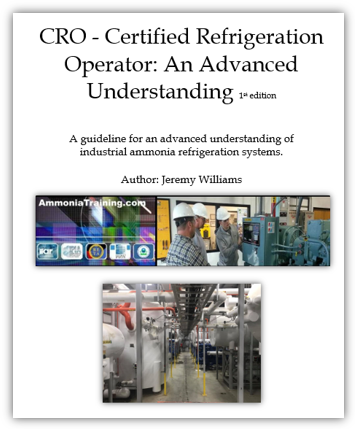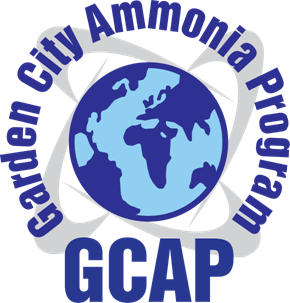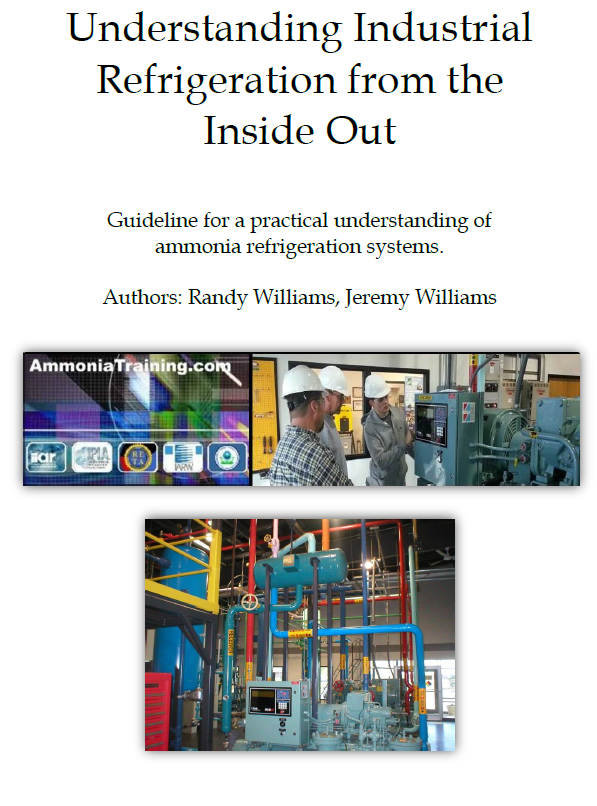GCAP’s Boot Camp (Ammonia I & II Combined) Competencies
Understanding Industrial Refrigeration from the Inside Out
June 2, 2014 GCAP revealed their new Ammonia Operator I Book titled “Understanding Industrial Refrigeration from the Inside Out“. Authors Randy Williams, and Jeremy Williams
This is a 15 Chapter text of what an operator/technician needs to knows learning how to the see the refrigeration from the inside out. The book has been copyrighted, and filed with the Library of Congress for a specific ISBN number. If you have taken GCAP PSM/RMP course and seen the quality of that book, this will be of equal. For a full detailed outline of the book Click Here.
-
Chapter 1: Getting Started
-
Chapter 2: Process Safety Management
-
Chapter 3: What You Need To Know About Ammonia
-
Chapter 4: Basic Electricity
-
Chapter 5: Foundation
-
Chapter 6: Heat Transfer
-
Chapter 7: Seeing Refrigeration From The Inside Out
-
Chapter 8: Four Steps Of Refrigeration
-
Chapter 9: Liquid Feeds
-
Chapter 10: Compressor Applications
-
Chapter 11: Condensers
-
Chapter 12: Different Systems
-
Chapter 13: Practice Exam
-
Chapter 14: Common Acronyms and Definitions
-
Chapter 15: Supplement Information
All of this material is covered or introduced to the
student at our seminar. Student should have all material studied
and understood before starting the next Technician Level.
This selection of material will allow success in companies
training structure and it follows the new IIAR Task Force Guideline.
Ammonia Refrigeration Basics / Ammonia Characteristics
Topics:
Ammonia sources, uses, and chemical characteristics; Environmental, hazardous material concerns; Temperature-pressure relationships; Materials compatibility; MSDS criteria; Safety
Learning Objectives:
-
Bhopal India Chemical Accident that led to Process Safety Management and Risk Management Programs.
-
OSHA Regulations
-
EPA Regulations
-
RAGAGEP: Recognized and Generally Accepted Good Engineering Practices.
-
IIAR Ammonia Refrigeration Library Awareness.
-
Employee Participation within a PSM/RMP program
-
Process Safety Information Awareness, Process Hazard Analysis Awareness, Standard Operating Procedures Awareness, Mechanical Integrity Awareness, Training Awareness, Management of Change Awareness, Pre-Startup Safety Review Awareness, Emergency Planning Awareness, Contractors Awareness, Hot Work Awareness, Trade Secret Awareness, Incident Investigation Awareness, Compliance Audit Awareness.
-
Requirements of 7 Operating procedures Awareness
-
Initials Startup
-
Normal Operations
-
Temporary Operations
-
Emergency shutdown, including the conditions under which emergency shutdown is required, and the assignment of shutdown responsibility to qualified operators to ensure emergency shutdown is executed in a safe and timely manner
-
Emergency Operations
-
Normal Shutdown
-
Startup following a turnaround, or after an emergency shutdown
-
-
Responsibilities under PSM/RMP Regulations Awareness
-
Name common uses of ammonia and describe benefits of ammonia refrigerant in terms of ozone depletion and global warming potentials (ODP and GWP).
-
Describe the properties of ammonia and explain how they affect the use of ammonia as a refrigerant.
-
Discuss the toxicity and flammability of ammonia and its classification as a hazardous material.
-
PPE Requirements, PEL, IDLH, Ammonia Sensors, DOT 1005, Fire Diamond, LEL, UEL, B2 Classification, Minimum rinse, Four Primary Injuries, Absorption Rate to Water, Expansion Rate at atmosphere
-
Discuss important features of ammonia saturation curves, reactions with metals, and MSDS criteria.
-
Name two standards governing ammonia refrigeration systems and describe the four main ammonia safety concerns, steps for their prevention, and first aid treatment in the event of exposure.
-
% to PPM conversions
-
Requirements of 100# releases
-
Minimum Protective Equipment
-
Determining to Point of Refrigerant Leaks
-
Sulfur Stick Applications
-
PH Paper Applications
-
Soap and Water Applications
-
Foundation Concepts
-
Square feet Calculations / Cubic Feet Calculations
-
Rates: CFM, GPM, Tonnage
-
Measuring Pressure: Formula, PSIG, PSIA, “hg
-
Converting Pressure
-
Altitude Corrections for Pressure
-
Principles of Heat Transfer: Radiation, Conduction, Convection
-
BTU
-
Celsius and Fahrenheit Measurements and Conversions
-
Sensible Heat / Latent Heat
-
Specific Heat
-
Conditions of a Refrigerant: Subcooled, Saturated, Superheated
-
First Law of Thermodynamics / Second Law of Thermodynamics
-
Latent Heat (BTU Content) of Ammonia and Water
-
Compression Ratios and Limitations
-
Block Flows, Process Flows, and P&ID Awareness
-
Hydrostatic Expansion
-
Log Books / Round Sheets
-
Valve Positions Importance
-
Pressure Drop / Line Resistance
-
Oil Draining Concepts and Dangers of Oil Draining
-
Tracking Oil
-
Theoretical Discharge Temperatures
-
Introduction to CIRO Trouble Shooting Screens
Single-Stage Ammonia Systems
Topics:
Positive-displacement systems; Refrigeration loads; Primary, secondary refrigeration system components; Components in parallel; Superheat; Single-stage pressure-enthalpy diagram
Learning Objectives:
-
Briefly compare absorption and mechanical compression systems, compare dynamic and positive-displacement compressors, and name those generally used in industrial ammonia refrigeration systems.
-
Compressors, Evaporators, Condensers, and Metering Devices
-
Explain how a positive-displacement compressor increases the ammonia vapor pressure.
-
Define British thermal unit (Btu), specific heat, sensible heat, latent heat, and tons of refrigeration.
-
Name four primary components in single-stage ammonia refrigeration systems and describe their functions.
-
Describe the functions of the oil separator, high-pressure liquid receiver, king valve, and suction accumulator in single-stage ammonia refrigeration systems.
-
Define superheat,
-
Insulation from High to Low side
-
CPR Systems
-
GCAP’s Airplane Analogy for Trouble Shooting
Two-Stage Ammonia Systems
Topics:
Compression ratio; Compressor capacity; Two-stage system division, Booster desuperheater, intercooler; Two-stage system components, performance; Complex two-stage systems
Learning Objectives:
-
Define compression ratio and explain its importance in single-stage and two-stage industrial ammonia refrigeration systems.
-
Explain why flash gas removal, booster discharge-vapor desuperheating, and interstage liquid cooling are desirable in the two-stage system.
-
Name the primary and secondary components of a two-stage refrigeration system and describe component functions.
-
Explain why a two-stage system requires less overall power than a single-stage system.
-
Swing Machines
Suction Accumulators and Intercoolers
Topics:
Need for suction accumulators; Accumulator design features; Liquid/vapor separation; Intercoolers; Shell-and-coil vs flash intercoolers; Alternate intercoolers
Learning Objectives:
-
Explain why suction accumulators are needed and describe the damage that can result from liquid entering the compressor.
-
Discuss the purposes and reasoning behind the design features, including the boil-out coil, of suction accumulators.
-
Describe the various ammonia refrigerant liquid/vapor separation criteria.
-
Explain how the intercooler deals with flash gas and desuperheats the booster discharge.
-
Describe basic differences between a flash intercooler and a shell-and-coil intercooler.
-
Describe typical configurations for alternate intercoolers provided with internally compounded compressors.
Evaporator Engineered Feeds
Topics:
Liquid overfeed, recirculation systems; Recirculation system advantages and disadvantages; Recirculation vessel design; Pumper drum system; Controlled pressure receiver system
Learning Objectives at the end of GCAP’s program is to understand the below information.
-
Describe the various functions performed within the recirculation vessel.
-
Discuss the advantages and disadvantages of recirculation systems.
-
Describe design features of horizontal and vertical recirculation vessels.
-
Discuss the surge-volume requirements of a recirculation system and reasons for high-level alarm/cutout controls on the recirculation vessel.
-
Describe the features and drawbacks of various kinds of liquid-refrigerant pumps.
-
Describe the operation of pumper drum (gas-pressure) recirculation systems and controlled pressure receiver (CPR) recirculation systems.
Covers gravity feed, overfeed, dump trap, CPR, and DX supply systems. Describes evaporator and evaporative condenser design, selection, and operation. Discusses various defrost systems-hot gas, electric, water, and glycol spray. Examines stop, shutoff, relief, check, solenoid, expansion, pressure-regulating, and float valves.
Liquid Ammonia Evaporator Supply Methods
Topics:
Gravity feed, liquid overfeed, pumped overfeed, dump trap, controlled pressure receiver – direct expansion, and flooded liquid chiller systems
Learning Objectives:
-
DX: Dry Expansion Evaporators
-
Flooded Evaporators
-
Explain how refrigerant flows in a thermosyphon system and describe the requirements for a surge drum in a gravity feed system.
-
List the benefits of a machine room liquid recirculation unit and benefits compared to direct expansion systems.
-
Describe the various level controls used in a recirculation unit and explain how the liquid refrigerant is pumped from the recirculation unit through the evaporator coils.
-
Describe how a dump trap functions and how it differs from a pumped overfeed system.
-
Discuss the differences between a recirculation unit and a CPR system.
-
Explain how a thermal expansion valve works and why a DX coil must have more heat transfer surface than an overfeed coil.
-
Describe the liquid feed and operation of flooded ammonia shell-and-tube fluid coolers.
Evaporators
Topics:
Evaporator operation and heat transfer principles; Tube design; Chillers; Air coils; Freezers; Ice makers; Specialty evaporators
Learning Objectives:
-
Discuss basic details of evaporator operation, including the use of secondary coolant.
-
List basic principles affecting evaporator heat transfer ability in DX and liquid overfeed systems.
-
Discuss the reasons for coil fins and enhanced tube designs.
-
Describe common DX and flooded liquid chillers.
-
Discuss the construction and operation of evaporators used as air coils (coolers), including the benefits of penthouse installation.
-
Describe the operation of various common kinds of freezers and ice makers.
-
Explain how subcoolers, intercoolers, and thermosyphon oil coolers function as evaporators.
Reciprocating Compressors
Topics:
Begins with the coverage of reciprocating compressors-their design, lubrication, efficiency, and application. Covers rotary vane compressor operation and limitations. Details screw compressors and the operation of related drive, lubrication, capacity control, and safety systems. Discusses oils and the importance of system lubrication.
Features of industrial ammonia reciprocating compressors; Capacity control; Lubrication; Efficiency; Application data; Compound compressors
Learning Objectives:
-
Briefly describe the evolution of ammonia reciprocating compressors.
-
Describe typical design features of today’s reciprocating compressors.
-
Explain how capacity control and proper lubrication are achieved in ammonia reciprocating compressors.
-
Explain how to use volumetric and adiabatic efficiency data and the performance factor in sizing or selecting compressors for an application.
-
Describe the function and basic design requirements of internally compounded reciprocating compressors.
Sliding-Vane Rotary Booster Compressors –
Topics:
Rotary vane compressor design and operation; Fixed volume ratio; Applicability; Limitations; Capacity control
Learning Objectives:
-
Describe the basic operation of sliding-vane rotary booster compressors.
-
Explain the principle of fixed volume ratio compressors.
-
Describe typical rotary compressor design features.
-
Explain why sliding-vane rotary compressors have been replaced by screw compressors.
-
Discuss the reasons for rotary vane compressor speed limitations and the causes and effects of blade wear.
-
Describe how capacity control is achieved in rotary compressors.
Oil-Flooded Screw Compressors
Topics:
Oil-flooded screw compressor operation; Fixed volume ratio; Capacity control in fixed – variable compressors; Efficiency; Compound compressors; Application criteria
Learning Objectives:
-
Discuss the developments that led to the use and acceptance of the oil-flooded screw compressor in industrial refrigeration.
-
Describe typical design features of single-screw and twin helical screw compressors.
-
Explain how the compression system works within screw compressors.
-
Compare fixed and variable volume machines and their applications.
-
Explain how the capacity-control slide valve and variable Vi slide stop function.
-
Describe the general range of application for screw compressors.
Screw Compressor Units
Topics:
Screw compressor systems; Drive systems; Lubrication, refrigerant/oil separation – oil cooling, economizer/side load, capacity control, microprocessor control, and safety systems
Learning Objectives:
-
Explain why screw compressors are provided as units and describe the main systems that make up the screw compressor unit.
-
Explain why a vertical or horizontal oil separator may be preferred and explain why check valves are used on the unit inlet and outlet connections.
-
Discuss drive methods and oil distribution methods used on screw compressors and describe tasks provided by the lubricant within the compressor.
-
Explain how the refrigerant vapor/oil separation system operates and list the methods and benefits of oil cooling in screw compressor units.
-
Discuss the beneficial uses of the side port and the operation of the screw compressor capacity reduction slide valve control system.
-
Name the codes and other criteria with which ammonia refrigeration systems must comply to establish and maintain a safe work environment.
-
Thermosyphon oil cooling, Liquid Injection oil cooling, and water/glycol cooling
Ammonia Systems Lubrication/Oil Management
Topics:
Need for lubrication; Miscibility; Viscosity; Lubricants and oils; Lubricant selection – handling and management; Separators; Low-side oil recovery
Learning Objectives:
-
Discuss the purposes of lubricants in ammonia systems.
-
Define the terms used to describe and specify lubricants and oils and discuss the importance of the miscibility and viscosity relationships between lubricants and ammonia.
-
Describe the proper methods for handling lubricants.
-
Explain how oil is separated from the refrigerant vapor within the screw compressor system.
-
Function of Oil Separator
-
Describe the IIAR-approved method for removing oil from the system low-side oil pots.
-
Name lubricants recommended for use with ammonia systems and explain the importance of using only specified lubrication products.
Air Unit Defrost Systems
Topics:
Reasons for defrost; Hot gas, soft hot gas, electric, water, continuous glycol spray – and room air defrost; Defrost cycle initiation and termination
Learning Objectives:
-
Explain why ice and frost form on a coil and discuss the problems resulting from this formation.
-
Describe the basic process of defrosting by means of hot gas from the compressor discharge.
-
Explain how the soft hot gas defrost system protects large industrial coils.
-
Describe common defrost methods that do not use hot gas-electric, water, continuous glycol spray, and room air.
-
Describe preset timer defrost methods.
Condensers
Topics:
Evaporative condenser basics and design features; Condenser selection; Condenser location; Refrigerant piping; Winter operation and capacity control; Water treatment
Learning Objectives:
-
Describe the basic differences between air-cooled, water-cooled, and evaporative condensers and discuss the main operating features of each.
-
Discuss the benefits of the evaporative condenser and explain why it has the lowest condensing temperature.
-
Describe the design components of an evaporative condenser and explain how they work together to provide cooling.
-
Discuss both the process of condenser selection and good and bad practices in locating condensers.
-
Describe proper piping and equalization practices for both single and multiple condenser installations.
-
Explain the need for condenser winterization and capacity control and discuss proper water treatment to control mineral and bacterial content.
Control Valves and Switches
Topics:
Safety relief, stop and shutoff, check, solenoid, hand expansion, pressure regulating, and float valves; Float valve switches and controllers
Learning Objectives:
-
Discuss the relief valve safety requirements as specified by the ASHRAE 15 code.
-
Explain why dual relief valves are used, describe proper positioning of the three-way diverting valve, and explain how to calculate relief valve flow capacity.
-
Describe the functioning of the various stop valves used on ammonia systems and explain why angle valves are preferred.
-
Describe the various kinds of check valves and solenoid valve uses in automatic control on ammonia refrigeration systems.
-
Describe the operation and functions of the hand expansion valve and describe typical pressure regulating valve applications and methods by which the valve is controlled.
-
Discuss system high-side and low-side float valve uses and describe the operation of mechanical float switches.
-
Discuss the benefits of the newer electronic level controllers in the automatic control of liquid levels, safety alarms, and system shutdown procedures.
Explains the effects of noncondensables on an ammonia system and the importance of their removal. Covers a wide range of piping considerations-sizing, flow rate, pressure drop, and others. Concludes with a thorough coverage of safety codes and programs, including ANSI/ASHRAE, IIAR, OSHA, and EPA information.
Purging Air and Noncondensables
Topics:
Materials to be purged; Effects of noncondensables; Power penalty; Purge point locations; Automatic purging; Economics of purging
Learning Objectives:
-
List common noncondensable vapors and discuss their effects in a refrigeration system.
-
Discuss the power penalty resulting from noncondensable gases in terms of compression and loss of refrigeration capacity.
-
Explain how to determine the presence of noncondensables.
-
Explain how to minimize the entrance of noncondensables and describe common entry points.
-
Compare the features and operation of manual and automatic purging equipment and name the best connection points for the purge unit.
-
Discuss the economic benefits of the purge unit in terms of typical payback time
-
Manual Purging and Automatic Purging
All the material above including lectures, which the students receives with the course, and hands on demonstrations in our hands on Lab, should help quick start the student’s career in the ammonia industry. No other school offers this amount of information for the first course. We feel that you can not build an operator in a week, it takes years and we want to get the material in their hands early so a complete training package so on the job training will be affective. Then this will prepare them to grow into an Industrial Refrigeration Technician. With the standard we follow, students will be successful.
Videos shown or given to student during week include:
-
GCAP’s PSM/RMP Awareness
-
Anhydrous Ammonia Incidents
-
Anhydrous Ammonia Training Tour Videos
-
IIAR’s Ammonia Refrigeration Systems
-
IIAR’s Evaporators
-
IIAR’s Compressors
-
IIAR’s Condensers
-
Plus many other GCAP in-house demonstration videos
All of this material is covered or introduced to the student at our seminar. Most of this course is running hands on equipment in the lab. This selection of material will allow success in companies training structure and it follows the new IIAR Task Force Guidelines.
Course primary text will be GCAP’s “CRO: Certified Refrigeration Operator; an Advanced Understanding”

Ammonia Operator II
Index
Chapter 1 – Mechanical Integrity
Chapter 2 – Heat Transfer
Chapter 3 – Psychometrics
Chapter 4 – Enthalpy
Chapter 5 – Low Side Vessels
Chapter 6 – Low Side Valves
Chapter 7 – DX Systems
Chapter 8 – Flooded Systems
Chapter 9 – Recirculated Systems
Chapter 10 – Defrost Applications
Chapter 11 – Practice Test
Common Acronyms and Definitions
Quick Reference Formula Sheet
SAT Charts
Closing Thoughts
Detailed Studies in the following subjects with DX liquid feeds
- Orifices of Expansion Valves
- Automatic Liquid Feed Controls
- Hand Feed Controls
- TXV Feed Controls
- Forces Involved in Opening / Closing
- Vessels
- Phase Seperation
- Troubleshooting Metering / Expansion valves
- Top Fed DX systems
- Bottom Fed DX systems
- Suction Line Accumulators
- Flash Gas / Tax Gas
- Distributers
- Super Heat Requirements
- Classifications of Superheat
- Bulb / Capillary / Power Head
- Mounting of Bulbs
- Internally Equalized TXV’s / Externally Equalized TXV’s
- Float Switches
- Level Controllers
- Gas Volume Temperature Comparisons
- Erratic DX Coils
- Slopover/ Burping/ Slugging/
- Advantages / Disadvantages
Detailed Annalist Liquid Feed to Flooded Evaporators
Topics:
- Term “Wetted”
- Gravity Systems
- Thermosyphon Systems
- Surge Drums
- Surface Area Comparison
- Recirculation Ratio
- Oil Control
- Troubleshooting
- Partially Flooded Systems
- Requirements
- Superheat
- Flash Gas / Tax Gas
- Liquid Make Up
- Phase Separation
- Advantages / Disadvantages
Detailed Annalist Liquid Feed to Overfeed Evaporators
Topics:
- Term “Wetted”
- Liquid Recirculation
- Pumps
- Centrifugal
- Positive Displacement
- Shaft Seal
- Semi-Hermetic
- Hermetic
- Liquid Make Up
- Recirculation Ratios
- Single Pumper Drums
- Double Pumper Drums
- CRP Systems
- Top Fed Overfeed
- Bottom Fed Overfeed
- Pump Pressure
- Pressure Drop
- Two pipe adjustments
- Pump Sizing
- Oil Removal
- Advantages / Disadvantages
Detailed Annalist Secondary Coolants Systems
Topics:
- Secondary Coolants
- Advantages / Disadvantages
- Glycols
- Brines
- Calcium Chloride
- Sodium Chloride
- Propylene Glycol
- Ethylene Glycol
- Two Pipe Systems
- Three Pipe Systems
- Heat Exchangers
- Shell and Tube
- Plate
- Plate and Frame
- Eutectic Point
Detailed Annalist Heat Flow
Topics:
- Thermal Conductivity
- K Factor
- U Factor
- Theoretical Analogy
- Fouling
- CFM Calculation
- HP Calculations
- Mass Flow Rate Calculations
- Theoretical Discharge Temperatures
- Subcooling Effect
Detailed Annalist Two Stage Systems
Topics:
- Simple 3 pressure two stage systems
- Multi pressured two stage systems
- Intercoolers
- Discharge
- Boosters
- Efficiency
- Compression Ratio of multi pressure systems
- Intermediate Pressure
- Theory
- Practical Operations
- Swing Compressors
- CO2 Cascade Systems
- CO2 Cascade Brine
- CO2 Cascade Compression
- Application
- Benefits and Advantages Compared to traditional two stage systems
- Horsepower Savings Two Stage and Cascade
- NewTon 3000 Cascade System
- VFD’s
- Microprocessors
Detailed Annalist Defrost
Topics:
- Coil Defrost
- Moisture / Air Relationship
- Pump Down
- Fan Delay
- Soft Start
- Bleed
- Defrost Timings
- Pressure Equalization
- Air Defrost
- Water Defrost
- Electric Defrost
- Continuous Defrost
- Niagra Defrost
- Hot Gas Defrost
- Regulator Pressure
- Consequences of Deviation of Defrost Practices
Detailed Annalist Enthalpy/Mollier Diagrams
Detailed Annalist Psychometric Chart
Detailed CIRO Exam Supplemental Package
Topics:
- This packet is used in the Ammonia Operator II course for analytical troubleshooting.
- Area of rectangle / circle
- Volume of a room / cylinder
- Brake Horse Power (BHP)
- Kilowatts (Kw)
- Power Cost in Dollars
- HP/TON
- Kw/TON
- Heat Transfer Equations
- Sensible
- Latent
- Compression Ratios
- Vacuum Conversions
- Saturation Charts
- Analyze Figure of a Two Stage System
- Analyze Figure of Top Fed DX Evaporator
- Analyze Figure of Vessel and Piping
- Analyze Figure of Forced Draft Evaporative Condenser
- Analyze 3 way valve with reliefs
- Analyze Figure of a Pump Package
- Analyze an Electrical Schematic
- Analyze all 24 screens from normal to abnormal conditions
- Analyze MSDS Sheet for Ammonia
Garden City Ammonia Program
2405 E. Fulton Plaza
Garden City , KS 67846
620-271-0037
620-271-0484 FAX
ammonia@pld.com
www.AmmoniaTraining.com
www.BoilerLicense.com
www.GcapCoolCast.com


